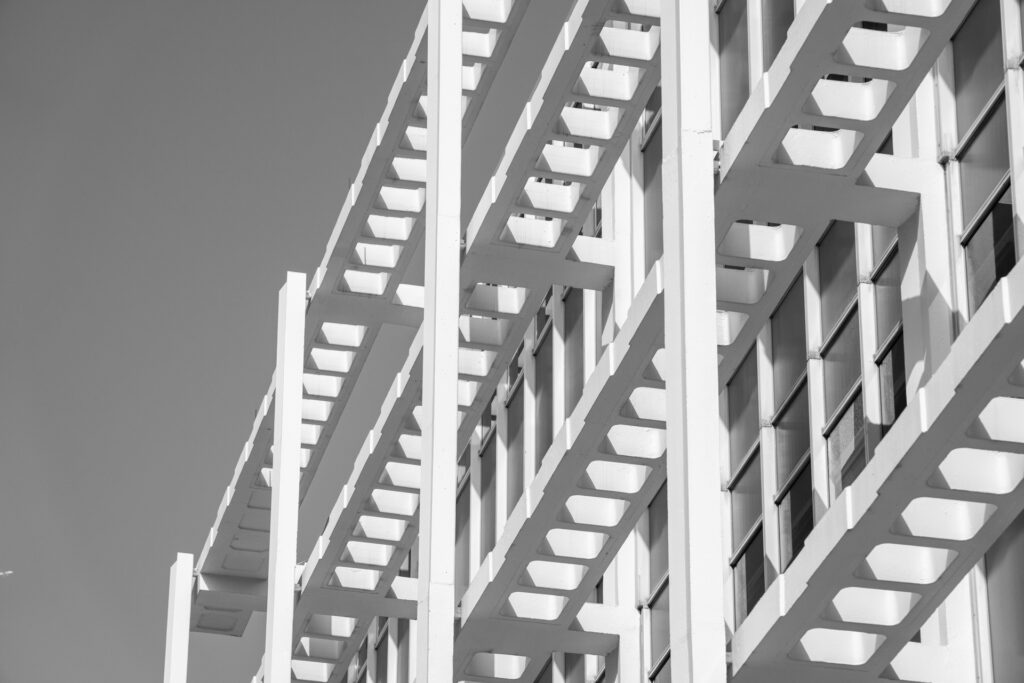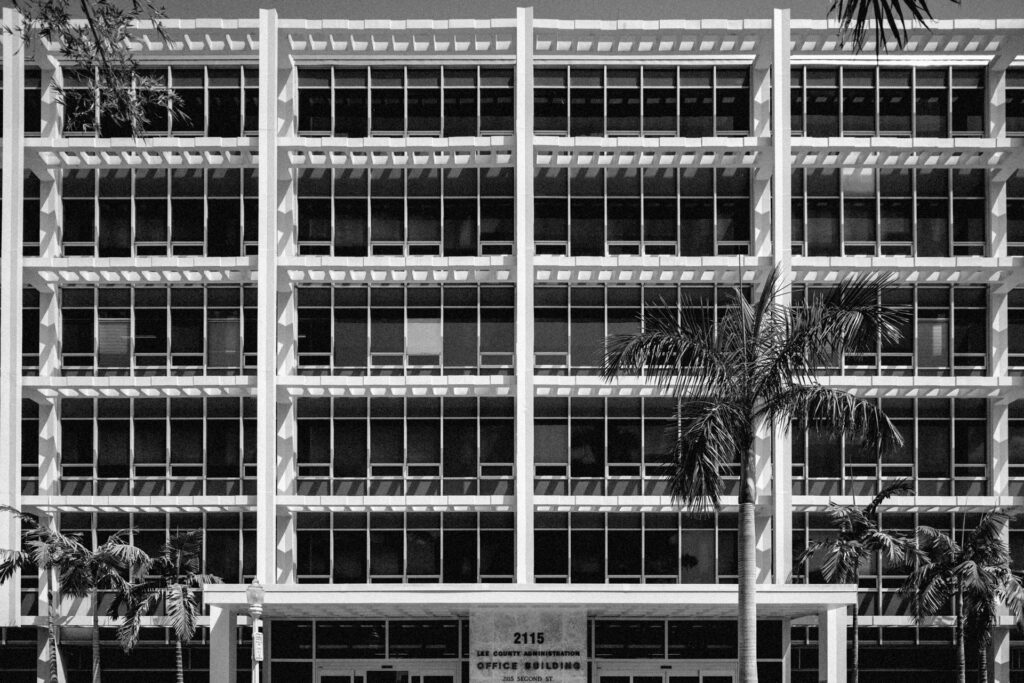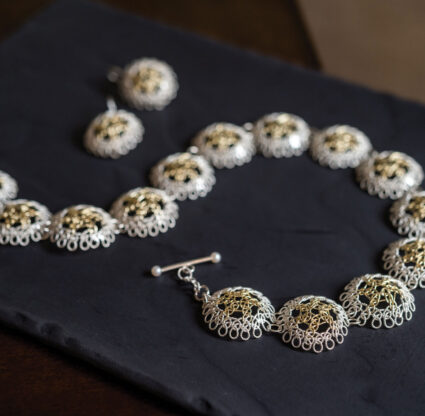When you consider notable buildings in Downtown Fort Myers, you may note Sidney & Berne Davis Art Center, with its Ionic columns and lofty portico, or the Art Deco Edison Theatre.
But, there’s more architectural weight and lore tucked within the downtown landscape if you know where you look—and have the right eye. When she sees buildings, Lee County-based, AIA award-winning architect Joyce Owens sees function, she sees form. She looks at balance, proportion, siting, order. By her standards, one architectural style reigns supreme in Southwest Florida—midcentury modern.
Joyce has spent considerable time educating locals on the postwar style and how it’s suited for our sunny, sandy, swampy climes. She’s written columns, curated the exhibit McMo_SWFL and created an accompanying website, documenting midcentury’s greatest hits locally. “I want people to know the architectural heritage that exists here,” she says, noting that midcentury was prevalent in Fort Myers due to the city’s rapid growth from the ’50s to ’70s, when the style was rampant nationwide. “There are so many interesting factors to consider when building in this area—the climate, the way we live indoors and outdoors.” Midcentury design—especially the Sarasota School iteration that developed in Southwest Florida—answers those needs, with well-ventilated, open areas; functional use of space; sustainable principles; and elevated footprints. “Florida buildings should be made for Florida—there should be a lightness and openness to them,” she says.
After taking in some art at Sidney & Berne in the spring, Joyce entices me to follow her on a tour to examine four midcentury marvels, all within a four-block radius. Across the street, the 1961 Inter-County Telephone & Telegraph stands in stark contrast to Sidney & Berne. Monolithic walls, scalloped low-relief tiles, and an undulating canopy floating over the entrance rise elegantly over Lee Street. “I love everything about this building,” Joyce says. “It used to have handsets printed on the front—a playful nod to its function.”
While modern design emerged as the antithesis to ornate classical architecture, midcentury came along in the fifties and re-introduced some flair. Still, the flourishes were considered and smart, never detracting from the function of the building, as seen with the architectural tiles that snake up Inter-County’s facade. The entryway canopy brings the building down to a human scale, making it inviting. “It says hello,” she notes. Built of aluminum, glass, and local brick and keystone, the former telecom center stands strong today, unscathed by storms.
As we walk toward Second Street to our next stop, Joyce points out the many things Fort Myers has gotten right in fostering an inviting downtown. “Most of the buildings have these nice overhangs, so if you’re walking around—shopping, going to eat—and it’s raining, you can go from place to place and not get wet,” she says. She mentions some of the dearly departed midcentury stars we’ve lost (like the Trailways bus depot in Naples) and some that remain but lie outside our path: “The First Harbour Tower, on First Street, is fantastic—it has these concrete cantilevers, I call them ‘eyebrows,’ separating each floor, hyperbolic paraboloids over the parking, and architectural breeze blocks running up the center.”

It’s mid-afternoon when we arrive at the Lee County Administration Building, and the sun casts soft shadows against the structure’s blue windows through the horizontal sunshade. “The paint is baked on the inside, a new technology then,” she says. The building was the most innovative in town when it was built in 1960, with construction inspired by Mies van der Rohe’s genre-defying Seagram Building in New York City. Glass and steel climb up the six stories with hypnotic uniformity. Curtain walls, which were increasingly prevalent in Chicago and New York, were new to Southwest Florida, and at first, locals lamented the look. “They thought it looked unfinished, like scaffolding,” Joyce says.
The modernist less-is-more and truth-to-materials principles arrived in Fort Myers in a big way with the Admin building. “This is a great example of the Sarasota School,” Joyce says, referring to the midcentury spinoff that evolved regionally in response to the climate. “Technology made it possible to have big expanses of glass, but in Florida, you had to think about the sun and flooding. They had to add overhangs, cross-ventilation, elevated floorplans.”
Looking across the street, I am struck by the bronzed rotunda that extends from the Lee County Administration East Building. “It is a lovely example of Brutalist architecture,” Joyce tells me. The architectural style emerged in Europe around the same time that midcentury was taking hold in the U.S. And, while some elements are the same—exposed concrete, simplicity—the monumental, windowless design isn’t very practical for Southwest Florida. We move on.
Across the street, we find another midcentury gem: Henderson, Franklin, Starnes, & Holt. Innovation and integrity are important principles of midcentury architecture, and the law office exemplifies both. Local keystone blends with steel and glass for a sturdy foundation that requires minimal upkeep. Windows are tucked behind vertical slats, providing shade during the harsh mid-morning and afternoon hours, and the sunshades, which appear to float, give the boxy structure an undeniable sense of style. As we approach, Joyce points to the vertical keystone tiles across the facade. “The stones create texture, and the screens create rhythm,” Joyce says. “It’s a simple building, but there’s still a lot of richness.”

Further down on Monroe Street, toward the Caloosahatchee River, we arrive at the Lee County Bank drive-in facility, which came a little later, in 1972, when Americans’ fascination with automobiles had fully taken hold. “They lifted the building and put the drive-in underneath to protect cars from the rain and so people would be shaded when it was sunny,” Joyce says. Meanwhile, the raised design protected the bank from flooding. Plus, it just looks cool. “It’s all masonry and heavy stone, but there’s this lightness to the building because it’s up in the air,” Joyce says.
Plenty of other midcentury gems pepper Fort Myers, Joyce tells me. She waxes poetic on the Cordova Houses, just on the outskirts of downtown. Built by two widowed friends in 1957, the side-by-side homes capture some of the best elements of the Sarasota School: angled roofs, sliding glass doors leading to screened-in porches and decorative brick screens that cast lovely shadows within. The boxy garage on the home to the left resembles a robot, with its small rectangular windows above the garage door—a reflection of midcentury’s playful mood.
The fascination of these buildings isn’t always obvious. They don’t insist upon themselves with ornate flourishes or imposing footprints. But once you stop and appreciate them, their allure is undeniable. “They’re so smart and chic,” Joyce says. “You look at all of these buildings today, and they look pretty much the same as they did 70, 80 years ago. How can we not want to learn from that?”





